La fase ocupacional tardía contiene evidencia de marcadores cronológicos del Postclásico Tardío, incluyendo cerámica Tohil Plomiza, obsidiana de Pachuca, Hidalgo y metalurgia de cobre. La cerámica plomiza corresponde a menos del diez por ciento de todos los materiales importados, pero fue recuperada de contextos tanto domésticos como ceremoniales. Similarmente, navajillas prismáticas producidas de obsidiana proveniente de las canteras de Pachuca están bien representadas en todas las estructuras muestreadas del Complejo Noreste. Aunque no se recuperaron objetos de cobre finalizados, investigaciones han recuperado una serie de rasgos del costado sur de El Coyote relacionados a la reducción sistemática de aleaciones de cobre provenientes de contextos geológicos. Fechas de radiocarbono calibradas con un rango de error 2σ colocan a estos contextos entre el 710-1040 d.C., con un agrupamiento de fechas ca. 900 d.C. Estos resultados son consistentes con un patrón descrito a lo largo de Mesoamérica y demuestran que a pesar de la variación existente en el uso de terminología cultural – Epiclásico, Clásico Terminal o Postclásico Temprano – hay uniformidad en la temporalidad de esta interacción macrorregional. Yo argumento que la inconsistencia en la terminología cultural puede quizás esconder un patrón más amplio de comercio e intercambio durante este período.
The ninth and tenth centuries a.d. were a time of transformation across Mesoamerica. For the Classic Maya kingdoms of the Southern Lowlands, this period was marked by dissolution of dynastic rule, abandonment of urban centers, and internecine warfare exacerbated by population pressure (Sharer and Traxler Reference Sharer and Traxler2006:513–520; Webster Reference Webster2002). In the Northern Lowlands, these processes of decline occurred a century or more later, but they nevertheless resulted in the cessation of monumental construction, abandonment of centers, and the rise of alternatives to dynastic rule (Andrews and Sabloff Reference Andrews, Sabloff, Sabloff and Andrews1985; Andrews et al. Reference Andrews, Andrews and Castellanos2003; Ringle Reference Ringle2017; Stanton and Bey Reference Stanton, Bey, Stanton, Taube, Coltman and Marengo Camacho2023). Although these phenomena may briefly precede or continue later, it was during the tenth century was when the process of collapse typically ran its course (Culbert Reference Culbert and Culbert1973a:16).
The tenth century was also a period of increasing international integration and commodification of goods across Mesoamerica, suggesting incipient development of mercantile exchange networks (Braswell Reference Braswell, Stanton, Taube, Coltman and Marengo Camacho2023; Braswell and Glascock Reference Braswell, Glascock and Glascock2002; Kepecs and Kohl Reference Kepecs, Kohl, Smith and Berdan2003:18; Sabloff and Rathje Reference Sabloff and Rathje1975). The emergence of a shared set of stylistic elements and symbols lends support for interpretations of widespread participation in expanding trade and communication networks (Boone and Smith Reference Boone, Smith, Smith and Berdan2003:189; Jordan Reference Jordan2016; Smith Reference Smith, Smith and Berdan2003; Smith and Heath-Smith Reference Smith and Heath-Smith1980). Many of these symbols are religious, which implies an ideological component accompanying economic, military, and political ambitions (Bey and Ringle Reference Bey, Ringle, Kowalski and Kristan-Graham2011:313; Burkhart Reference Burkhart1992; Ringle Reference Ringle2004; Ringle et al. Reference Ringle, Negrón and Bey1998; Stanton et al. Reference Stanton, Taube, Coltman, Stanton, Taube, Coltman and Marengo Camacho2023; Taube Reference Taube, Stanton and Kathryn Brown2020). Furthermore, the tenth century is characterized by macroregional changes resulting in shared material culture and symbolism (Houston Reference Houston2014:46; Jordan Reference Jordan, Stanton, Taube, Coltman and Marengo Camacho2023) in a manner that makes the Postclassic Mesoamerican world distinctive from regionalized Classic traditions (Freidel Reference Freidel, Sabloff and Wyllys Andrews1986:419–420; Geurds Reference Geurds, Stanton, Taube, Coltman and Marengo Camacho2023; Kepecs Reference Kepecs, Kowalski and Kristan-Graham2011; Kepecs et al. Reference Kepecs, Feinman and Boucher1994). Understandably, this transformative century has captured the attention of archaeologists for generations (e.g., Chase and Rice Reference Chase and Rice1985a; Culbert Reference Culbert1973b, ed.; Demarest et al. Reference Demarest, Rice and Rice2004; Sabloff and Andrews Reference Sabloff and Andrews1985; Stanton et al. Reference Stanton, Taube, Coltman and Marengo Camacho2023, ed.).
The presence of Tohil Plumbate pottery is a widely accepted indication that a community has crossed the Classic-to-Postclassic threshold. Anna Shepard's extensive monograph (Reference Shepard1948) described the range of variation for this tradeware and argued that this “index fossil” serves as a marker for Early Postclassic contexts. Research by Hector Neff and colleagues identified the Pacific coast of the Soconusco region as the geographic origin for this ware and clarified the circumstances for the widespread distribution of these vessels (Neff Reference Neff2003; Neff and Bishop Reference Neff and Bishop1988). More recent studies by Neff and colleagues (Mendelsohn Reference Mendelsohn, Robinson and Davies2023; Neff Reference Neff, Robinson and Davies2023; Neff et al. Reference Neff, Castillo, Sakai, Stanton, Taube, Coltman and Marengo Camacho2023) have refined the chronology for the production and export of fancy Tohil Plumbate to the century (or two) following a.d. 900. The presence of Tohil Plumbate at centers such as Tula (Mastache de Escobar et al. Reference Mastache de Escobar, Cobean and Healan2002:230) reveals an increased importance and capacity for exchange networks to move resources across regions (Jadot et al. Reference Jadot, Pereira, Neff and Glascock2019; Neff Reference Neff and Martinón-Torres2014). In addition, the speed with which this tradeware traveled from polity to polity demonstrates its value as a horizon marker (Diehl Reference Diehl and Rice1993).
In southeastern Mesoamerica, especially along the contiguous borders of the modern nations of Guatemala, Belize, Honduras, and El Salvador, the presence of Tohil Plumbate is also identified as a chronological marker. Here, the tradeware is commonly associated with green obsidian from the Pachuca source in Hidalgo, Mexico. Obsidian from this source is traded far from central Mexico, either as polyhedral cores commonly prepared with pecked-and-ground platforms or as finished blades (Braswell Reference Braswell, Smith and Berdan2003; Golitko and Feinman Reference Golitko and Feinman2015; Golitko et al. Reference Golitko, Meierhoff, Feinman and Williams2012; Healan Reference Healan2009). The increased frequency of this source material in Postclassic assemblages may be attributed to the intensification of mining practices at the Pachuca quarry and changes in the administration of tribute by leaders at Tula (Healan Reference Healan1993, Reference Healan, Kowalski and Kristan-Graham2011). The greater volume and circulation of green obsidian is therefore due to significant changes at the point of extraction, production for nonlocal consumers, and expanding capacities for trade across greater Mesoamerica.
An additional marker for the Classic-to-Postclassic transition is the presence of copper bells and ornaments. Extensive work undertaken by Dorothy Hosler (Reference Hosler1995, Reference Hosler, Smith and Berdan2003, Reference Hosler2009; Hosler et al. Reference Hosler, Shugar, Simmons, Shugar and Simmons2013) traces the origins of Mesoamerican metalworking to communities in west Mexico. Technological knowledge shared by Ecuadorian artisans circa a.d. 650 resulted in bells, clothing ornaments, rings, and a few functional items such as tweezers and needles. A second, lesser understood metalworking tradition began several centuries later in southeastern Mesoamerica (Cockrell and Simmons Reference Cockrell and Simmons2017; Simmons and Shugar Reference Simmons, Shugar, Shugar and Simmons2013), and by the end of the Early Postclassic period, at least four metalworking zones were producing or recasting metal objects (Paris et al. Reference Paris, Baquedano, Lope, Masson, Kennett, Serafin and Meanwell2023:432). The distribution of these goods at Maya centers suggests that by the Postclassic period, metal objects served as status or luxury goods and were no longer subject to sumptuary restrictions of earlier imports (Paris Reference Paris2008; Simmons and Shugar Reference Simmons and Shugar2008).
The distribution of these temporal markers reflects both continuity with Classic traditions and change indicative of later Postclassic phenomena. On the one hand, the acquisition and use of Tohil Plumbate and contemporary imports is indicative of prestige goods exchange (Friedman and Rowlands Reference Freidman, Rowlands, Freidman and Rowlands1977; Jordan Reference Jordan, Stanton, Taube, Coltman and Marengo Camacho2023; Joyce Reference Joyce2019). These small vessels are associated with drinking rituals, public displays, and interment as grave goods (Bey and Ringle Reference Bey, Ringle, Kowalski and Kristan-Graham2011:312–313; Neff Reference Neff and Martinón-Torres2014). Valued as a prestige good, their uneven distribution within sites and their surrounding settlement often marks inequality and social differences (Urban et al. Reference Urban, Schortman, Ausec and Aimers2013a). On the other hand, prismatic blades reduced from Pachuca source materials are widely distributed across households regardless of status—a common treatment for commodities and utilitarian goods. The patterns of distribution share characteristics with both earlier exclusionary modes of exchange and the market-oriented modes of Late Postclassic economies (Hirth Reference Hirth1998). Other archaeologically salient markers are often bundled with this combination of Tohil Plumbate and green obsidian in southeastern Mesoamerica, including alterations in site layouts, metallurgy, and significant changes in social and political organization (Healy Reference Healy, Lange and Stone1984:148). Taken together, the transition from Classic regionalized polities to Postclassic macroregional integrated exchange networks warrants attention on its own merits.
Models of this emergent mercantile network depend on reliable and aligned chronologies that account for cultural developments within a temporal framework anchored by absolute dates. To that end, the goals of this article are twofold. First, I present archaeological evidence from the pre-Columbian site of El Coyote, northwestern Honduras. The political economy of this community underwent significant transformations, and a series of radiocarbon assays place these cultural changes at the end of the ninth century and beginning of the tenth century. The second goal is to consider the broader regional and interregional implications of the evidence. Here, I argue that the pattern described from El Coyote is not unique. Despite regional and semantic variation in the designation of this time period—Epiclassic, Terminal Classic, or Early Postclassic—there is a great deal of continuity in the manifestation of this archaeological pattern between a.d. 900 and 1000. Moreover, these macroregional exchanges characterize the tenth century as a time of profound innovation within both material and symbolic spheres of interaction (Stanton et al. Reference Stanton, Taube, Coltman, Stanton, Taube, Coltman and Marengo Camacho2023:7). The intensity and scale of these exchanges surpassed those of earlier centuries and foreshadow the greater connections of the Postclassic Mesoamerican world.
El Coyote
El Coyote is a pre-Columbian center located in the rugged terrain of the Department of Santa Barbara, Honduras (Figure 1). The site was constructed on a narrow terrace overlooking the Cacaulapa River, a tributary of the Chamelecon River 4 km to the north. Together, these waterways facilitate communication and transportation to broader valleys in the neighboring areas, such as La Florida, Quimistan, Naco, the middle-Ulua drainage, and the Sula Plain. The Classic Maya city of Copan lies 130 kilometers to the southwest. Although passage through the Cacaulapa Valley is possible, there is little terrain suitable for agriculture. The largest tract of arable land is less than 1 km wide, quite different from the expansive potential for farming in the Naco Valley and Sula Plain.
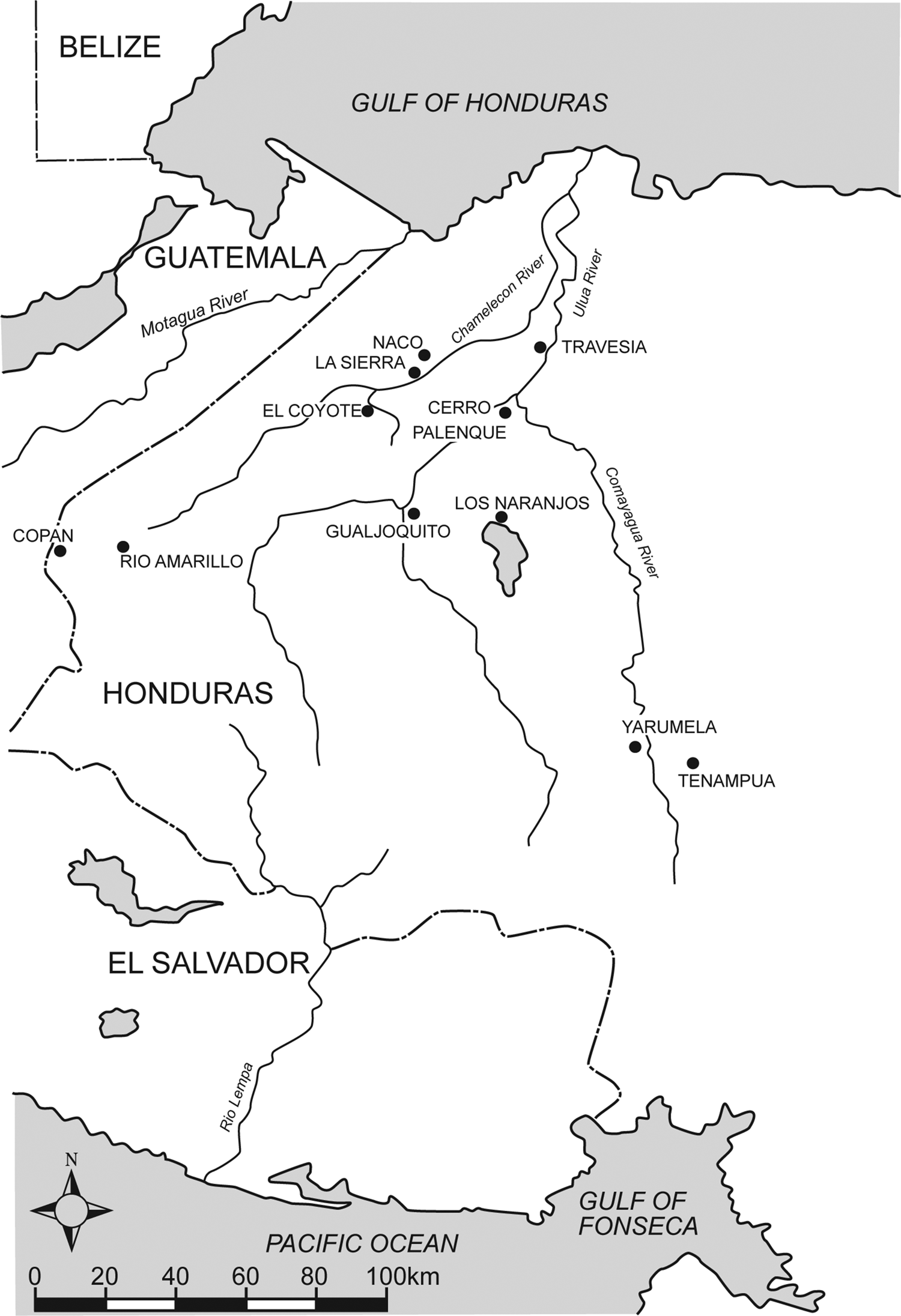
Figure 1. Location of El Coyote and other sites mentioned in the text.
Archaeological investigations of El Coyote began in 1999 with an approximately 6 km2 systematic pedestrian survey directed by Patricia Urban and Edward Schortman (Urban et al. Reference Urban, Schortman and Stockett1999). Five seasons of subsequent research by the Proyecto Valle de Cacaulapa have recorded 57 sites ranging in size from artifact scatters to concentrations of stone-faced platforms around sizable plazas. Excavations have been conducted at 10 sites, and more than 170,000 artifacts have been analyzed (Urban Reference Urban2007). A central concern of the research project is the role of craft production in political organization (McFarlane and Schortman Reference McFarlane and Schortman2017; Stockett Reference Stockett2007; Urban et al. Reference Urban, Schortman, Ausec and Aimers2013a; Wells Reference Wells2003, Reference Wells, Wells and Davis-Salazar2007). The relationship among craft production, interregional interaction, identity, and power is an interest shared by investigators in neighboring regions (e.g., Goodwin et al. Reference Goodwin, Johnson and Figueroa2021; Hirth et al. Reference Hirth, Hirth, Hasemann and Pinto2023; Joyce Reference Joyce1986, Reference Joyce, Goodwin, Johnson and Figueroa2021; Joyce et al. Reference Joyce, Hendon and Lopiparo2014; Schortman and Urban Reference Schortman and Urban1994, Reference Schortman and Urban2011; Schortman et al. Reference Schortman, Urban and Ausec2001; Urban et al. Reference Urban, Ausec, Wells and Rice1997; Urban and Schortman Reference Urban and Schortman2004).
El Coyote was a monumental center consisting of 415 surface-visible structures, and it was more than 12 times the size of the next largest community in the valley. Initial domestic activity at the site (ca. 300 b.c.) was dated by contexts containing Late Preclassic pottery. These early remains, however, are obscured by later constructions associated with the peak in population and expansion of public architecture during the Late Classic period (Wells Reference Wells, Wells and Davis-Salazar2007:39). Transformations during the Terminal Classic period include the abandonment of the Late Classic monumental ceremonial center and a shift in focus to the north end of the site, where an entirely new civic and residential complex was constructed (McFarlane Reference McFarlane2005). In this article, I am primarily concerned with questions related to the timing of these Classic-to-Postclassic transformational events, but continuous occupation of El Coyote persisted through the eleventh century a.d.
Between a.d. 600 and 800, a large investment of resources and labor produced the architectural complex surrounding the Main Plaza (Figure 2). Built around an orthogonal plaza, the tallest structures are on the east and a north–south axis are clearly marked with public ritual spaces north of a ballcourt and elite residences to the south. A causeway, contemporary with these Late Classic developments, enhances a natural ridgeline terminating at the north end of the Main Plaza. Elements of these site-planning principles can be traced to neighboring centers (Joyce et al. Reference Joyce, Hendon, Lopiparo, Bowser and Zedeño2009) and more broadly throughout southeastern Mesoamerica (Ashmore Reference Ashmore and Robinson1987, Reference Ashmore1991, Reference Ashmore, Golden and Borgstede2004; Ashmore and Sabloff Reference Ashmore and Sabloff2002). Along with the built environment, the natural topography of this steep valley served to restrict or control movement into the public ceremonial plaza and associated domestic structures of the rulers. Put simply, the Late Classic architecture served to elevate the elite and to discipline the movement of others, presumably to reinforce power, authority, and status inequalities.
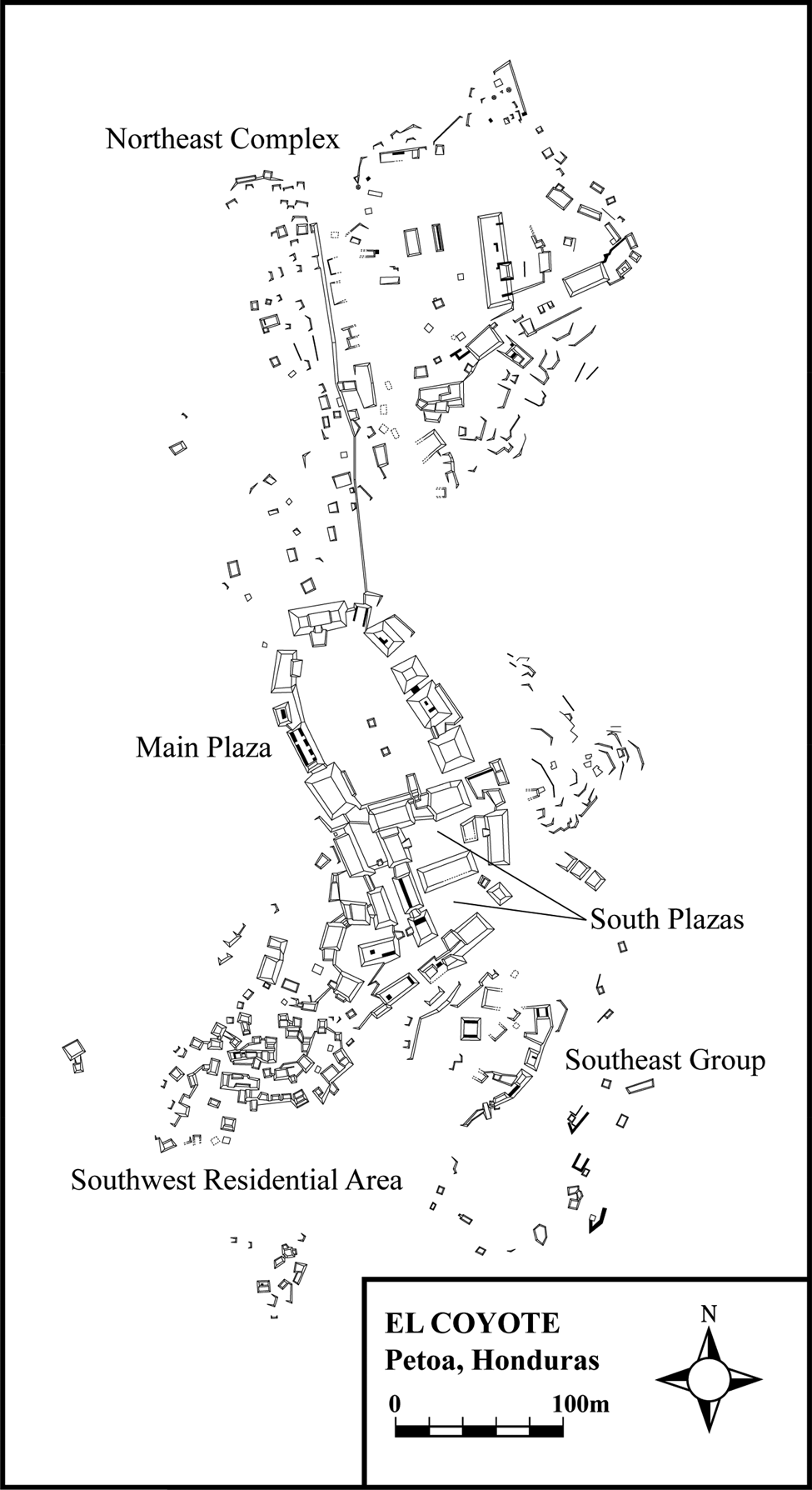
Figure 2. Site layout of El Coyote.
Test excavations in and around the Main Plaza focused on material residues associated with cultural activities, primarily the role that collective action and feasting played within the ritual economy of Late Classic El Coyote, leaving more extensive clearing of the monumental architecture for future investigations (Wells Reference Wells2004). Far more is known about the humbler households to the south. Few of these 55 structures rise above 2 m, and these residences are densely packed, filling the available flat terrain between a perennial tributary to the Cacaulapa River and the Cerro Macutalo, which rises steeply to the west of the site. Along with the monumental public architecture, this residential zone grew during the Classic period. When the Main Plaza was abandoned during the ninth century, these households underwent significant modifications. The multiroomed residences were filled in to form extensive platforms supporting single-roomed wattle-and-daub superstructures. These architectural renovations in the south coincide with the construction of the Northeast Complex, a new architectural zone constructed at the northern end of the site.
The Northeast Complex is made up of 131 surface-visible structures (Figure 3). Unlike the elevated platforms of the Main Plaza, none of the buildings in the Northeast Complex rise more than 2 m above ground surface, and most structural remains have an elevation of less than 0.5 m. These low-lying structures were built atop a previously vacant broad terrace and Classic-period causeway along the western margin. These buildings were organized by quite different site-planning principles than those identified in Classic-period El Coyote. The use of closed plazas to control pedestrian traffic was abandoned in favor of open public spaces. Movement within the Northeast Complex was unrestricted by the built environment except within households. Here, patios and private spaces can be identified with residential units, but they are not aligned with cardinal directions. Indeed, the only shared alignment (7° west of north) is the ballcourt and Structure 220, which point to a narrowing of the valley and the downstream flow of the Cacaulapa River.
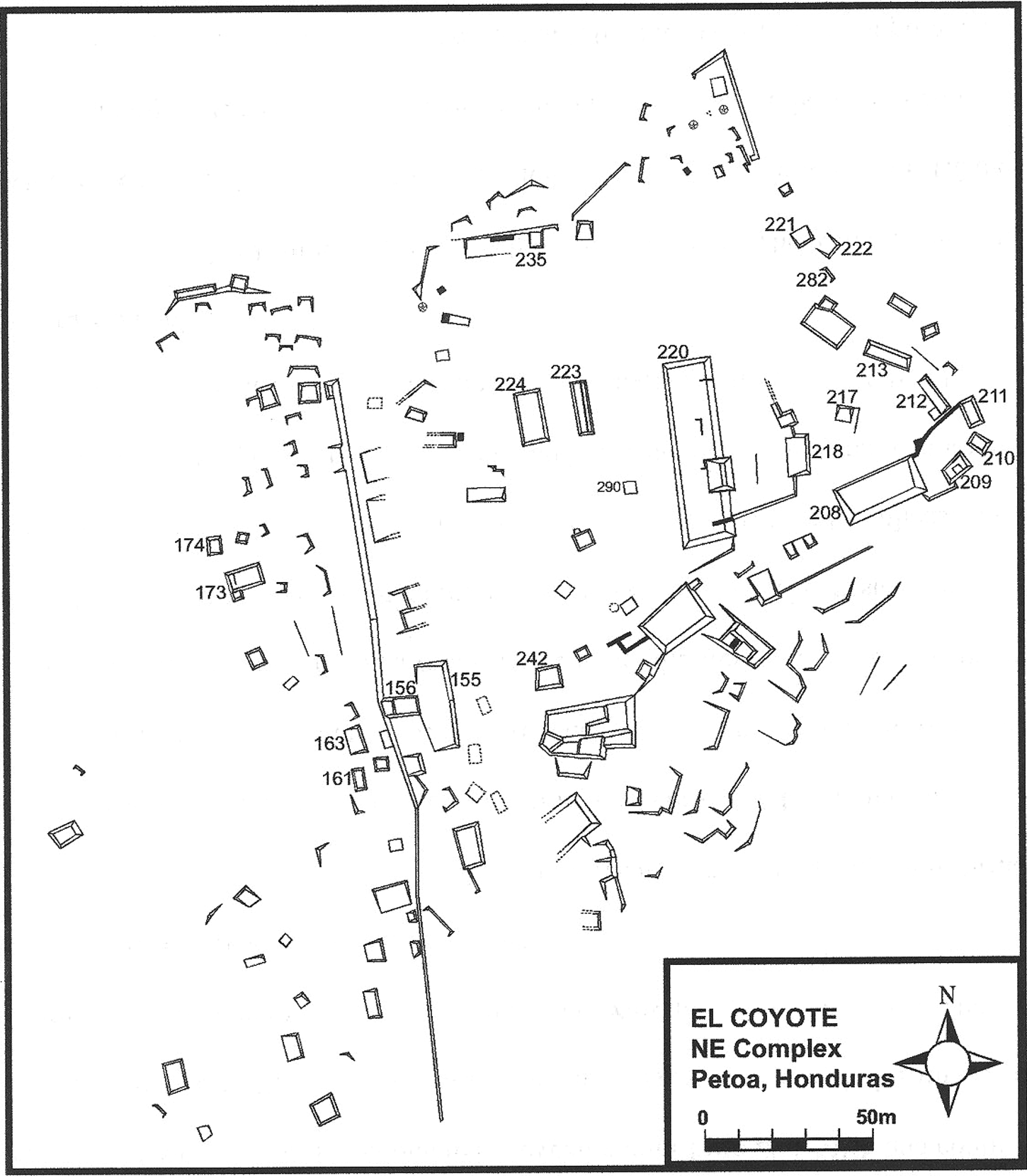
Figure 3. Northeast Complex. Excavated contexts indicated by structure number.
The organization of the Northeast Complex differs from Late Classic–period El Coyote, yet many of the functional components were retained, albeit in new configurations. Ceremonial architecture, a ballcourt, areas for congregation and public ritual, and large-scale construction efforts are recognizable elements of the Northeast Complex. The divergence from earlier organizational principles leaves the impression that the Northeast Complex was designed to accommodate the entire population for community-wide events without the use of imposing architecture or secrecy reinforced by closed spaces. Research in neighboring areas of Honduras suggests that these patterns in support of relatively unrestricted movement within ceremonial areas were well established at contemporary sites (Agurcia Fasquelle Reference Agurcia Fasquelle, Urban and Schortman1986; Baudez and Becquelin Reference Baudez and Becquelin1973; Canby Reference Canby and Tax1951; Dixon Reference Dixon1989; Joesink-Mandeville Reference Joesink-Mandeville, Henderson and Beaudry-Corbett1993; Joyce Reference Joyce1986, Reference Joyce1991; Manahan Reference Manahan2004; Stone Reference Stone1957; Urban Reference Urban, Urban and Schortman1986; Wonderley Reference Wonderley, Chase and Rice1985).
The central architectural element of the Northeast Complex is the 51 m long range structure, Structure 220 (Figure 4). The building was primarily composed of river cobble. A broad inset stair provides access to the summit from the west side. This stair was faced with cut stones, which were likely repurposed from the abandoned monumental architecture in the Main Plaza. The summit of the range structure consists of a large western-facing room, the floor of which was surfaced with a bright yellow-clay plaster. The entire building was periodically swept clean, and no large midden deposits were recovered in association with Structure 220. The scale, organization, and absence of domestic remains all suggest a civic-ceremonial function—likely a council house, where leaders met in full view of the community. Decisions made by and on behalf of the populace align with a less-stratified corporate political organization (Blanton and Fargher Reference Blanton and Fargher2016; Blanton et al. Reference Blanton, Feinman, Kowalewski and Peregrine1996; Mills Reference Mills and Mills2000; Peregrine Reference Peregrine2001) and reveal another contrast with the more-centralized exclusionary power wielded by Late Classic rulers.
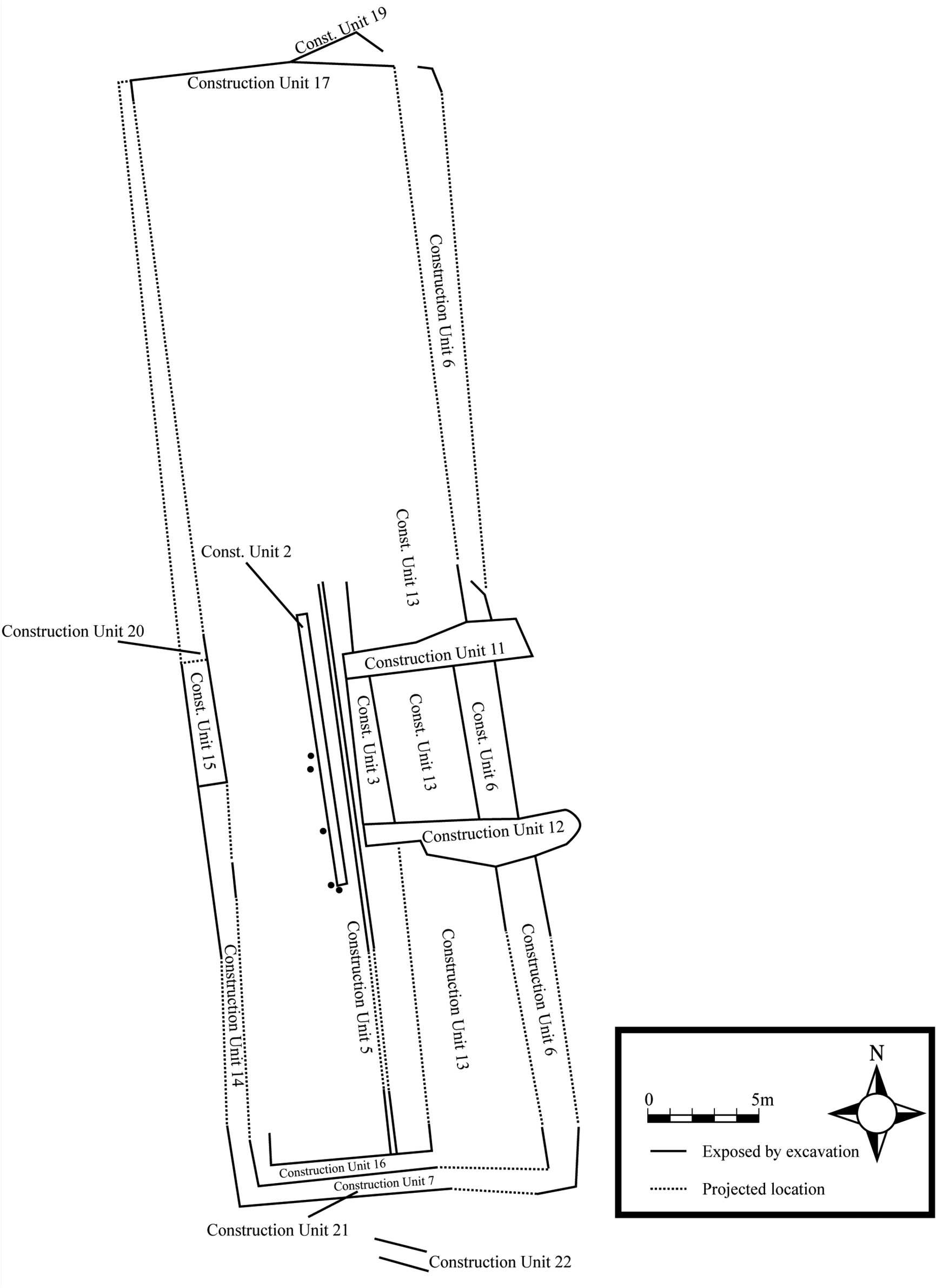
Figure 4. Plan of Structure 220.
Compared to remains recovered elsewhere at El Coyote, the short occupation phase of the Northeast Complex resulted in limited material evidence. Cultural contexts are shallowly buried, and, frankly, it is remarkable that the materials are in such an excellent state of preservation. Architectural features and associated contexts were easily exposed through areal excavation, rarely carried to a depth of more than 0.25 m below ground surface. Overall, construction techniques were expedient, building materials consisted of river-rounded cobbles, and the occasional cut-stone block was likely robbed from the abandoned Main Plaza. Foundations of many buildings were set directly on the ancient ground surface to support wattle-and-daub walls. Given the expedient construction style, it was necessary to clear most structures entirely to determine the limits and organization of buildings. By the end of two seasons of research, 2,135 m2 of the Northeast Complex were cleared.
Of the 131 structures in the Northeast Complex, 26 were exposed, revealing little differentiation in the investment of labor and resources in domestic buildings. No segment of society was able to manipulate labor surpluses, as indicated by a lack of outsized residences. Material remains reflect a similar modest lack of difference in access to nonlocal resources, labor, wealth, or other markers of status difference. Local resources, including specialized production knowledge, were either available to all or absent. Finally, prestige goods or widely circulated tradewares were present in every structure sampled. Taken together, the political economy following the abandonment of the Main Plaza lacked the markers of economic inequality, status difference, and centralized hierarchical organization so common to Classic-period societies in the region (McFarlane Reference McFarlane2005).
Northeast Complex chronology
Samples collected from sealed contexts associated with public and domestic structures in the Northeast Complex are presented in Table 1 and Figure 5. The 2σ calibrated results for most of these assays fall between a.d. 710 and 1040. A single outlier (176821) has an intercept date to cal a.d. 660. This early date was collected from the construction fill of Structure 242, a building situated on a terrace between the Main Plaza and the Northeast Complex. Structure 242 is one of the few buildings in the Northeast Complex with evidence from the earlier and later periods at El Coyote. Here, the material assemblage reflected a continuity of occupation and yielded diagnostic markers corresponding to both the Classic and Postclassic periods. This early date aside, most of the intercepts fall between cal a.d. 860 and cal a.d. 960.
Table 1. Calibrated 14C dates from the Northeast Complex, El Coyote.
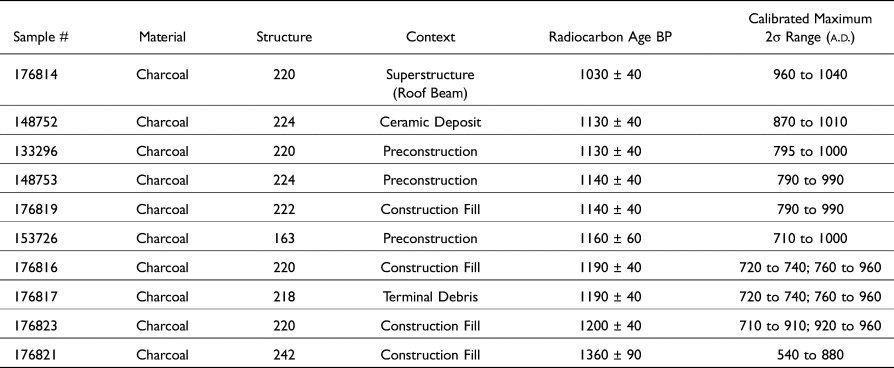
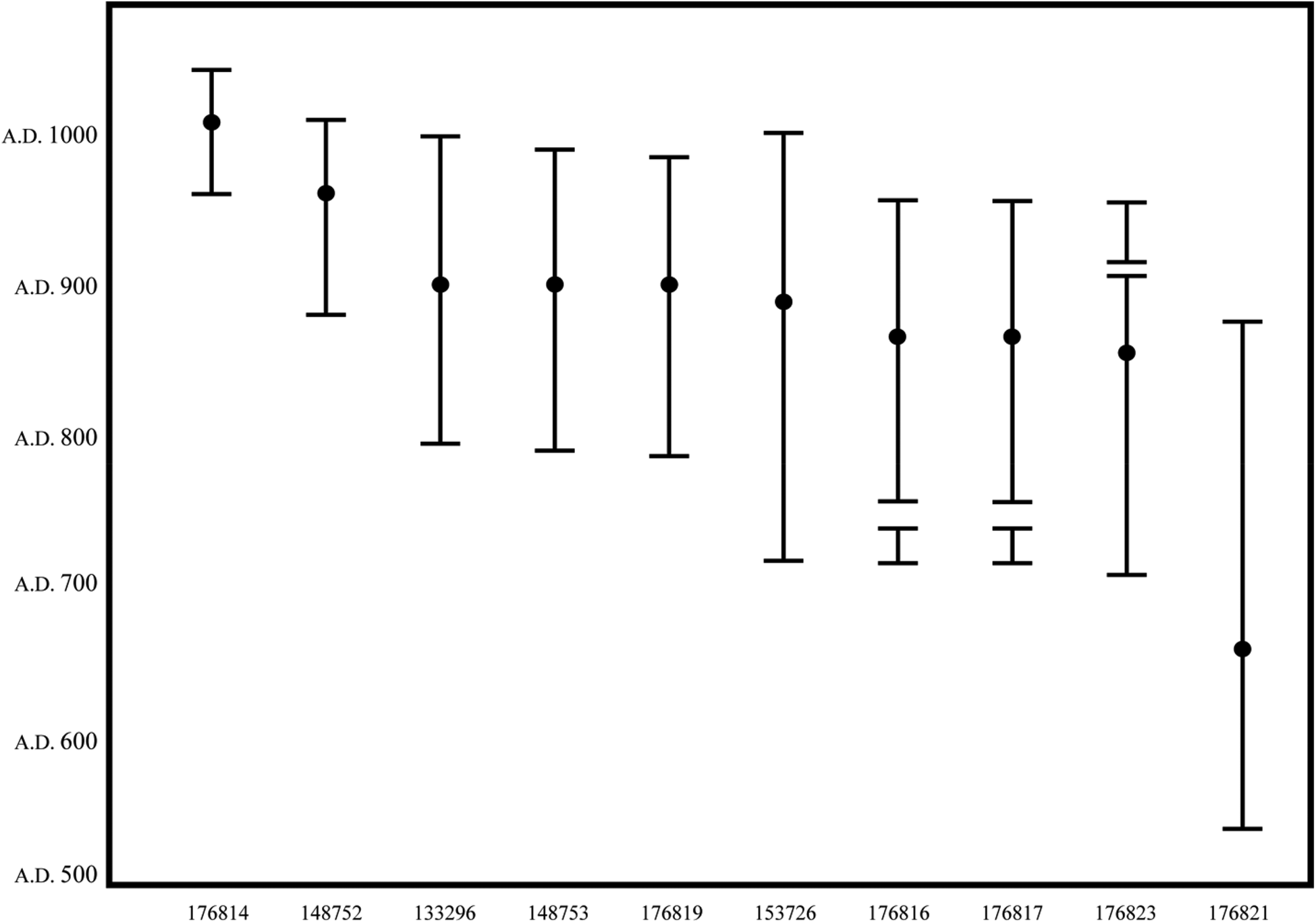
Figure 5. Calibrated 14C ± 2σ dates from the Northeast Complex.
The sample with the latest date (176814) was taken from a burned roofbeam from the superstructure of Structure 220. This feature represents what was likely the final event associated with the public range structure around which the Northeast Complex was constructed. The absolute dates support an interpretation that Structure 220 was raised near the end of the ninth century. The public ceremonial building was utilized and modified for more than a century. However, no efforts were made to renovate this building following its collapse in the early eleventh century.
Although there is a concentration of calibrated intercept dates circa a.d. 900, many of these assays have multiple peaks or 2σ probability ranges spanning the ninth and tenth centuries. I truncate this range to the tenth century, in part to simplify the following discussion but also because it is consistent with the chronology of the pan-Mesoamerican material pattern I describe below. The late phase of El Coyote came to an end during the eleventh century when the site was abandoned. The circumstances surrounding the end of El Coyote are unclear. Nevertheless, the Northeast Complex raises questions regarding the persistence of this community into the Postclassic period and its articulation within the regional chronology.
Three additional facets of the El Coyote assemblage are chronologically relevant: Tohil Plumbate pottery, the chipped stone remains—especially obsidian from the Pachuca source, and evidence for copper smelting. Not only do these lines of evidence bolster the chronological placement of the Northeast Complex to the tenth century, but through this evidence, it is possible to reconstruct the patterns of behavior that connects the community of El Coyote to the macroregional transformations across Early Postclassic Mesoamerica.
Northeast Complex pottery
As noted above, the Northeast Complex represents one of the best-preserved ninth- and tenth-century contexts in the region. Therefore, the sampling strategy sought to classify the greatest quantity of ceramic material from each structure. Additional consideration was given to perceived function: domestic, public, and ritual architecture. When identified, midden contexts were given greater attention. By the conclusion of analysis, samples were taken from 20 of the 26 excavated structures in the Northeast Complex.
During the 2000 and 2002 field seasons, 84,567 sherds were collected from excavated contexts in the Northeast Complex. Of these, a sample of 20,857 sherds was analyzed, or roughly 25 percent of the assemblage. Additionally, nine complete or nearly complete vessels were recovered, reconstructed, and classified. Ceramic analysis was undertaken by Patricia Urban, Edward Schortman, and Marne Ausec using the type-variety-mode approach (Gifford Reference Gifford1960; Smith et al. Reference Smith, Willey and Gifford1960). Classification of the materials recovered from the Northeast Complex was set within a broader context of the lower Cacaulapa Valley ceramic classification of 200,000 specimens and extensive studies in the neighboring Naco and middle-Ulua valleys (Urban Reference Urban, Henderson and Beaudry-Corbett1993a, Reference Urban, Henderson and Beaudry-Corbett1993b; Urban et al. Reference Urban, Schortman, Ausec and Aimers2013a).
Investigations at many of the smaller settlements in the area have found a pattern of pottery production at the household level. At some sites, such as Rancho del Rio in the lower Cacaulapa Valley, pottery production was undertaken for household consumption (Urban Reference Urban2016:245). Pottery was also produced at El Coyote, albeit less intensively than at Las Canoas. Excavations conducted along the western limits of the Southwest Residential Area (Figure 2) uncovered firing facilities and implements associated with the manufacture of ceramic vessels (Schortman Reference Schortman2018). Vessels produced locally at El Coyote can be confidently identified given the well-understood ceramic history of the surrounding areas and through ongoing petroglyphic and Instrumental Neutron Activation Analysis of ceramics (Urban et al. Reference Urban, Schortman, Ausec and Aimers2013a).
These locally manufactured wares are relatively simple in form and surface treatment (Table 2). Analyses undertaken by Urban and colleagues (Urban et al. Reference Urban, Schortman, Ausec and Aimers2013:178–179) have identified chronologically sensitive characteristics of the local assemblage. These measures include the declining frequency of tan pastes and an increased frequency of orange-brown pastes. Orange-slipped vessels decline in frequency from the Late Classic period through the Terminal Classic period and are absent in Early Postclassic contexts. Red-on-natural forms share this declining frequency but continue to be manufactured into the Early Postclassic period. Red-wash and red-slip surface decorative modes increase over time from the Late Classic period into the Early Postclassic period. However, smoothed-surface treatment is by far the most common finish on utilitarian wares in late-phase Northeast Complex occupations.
Table 2. Local pottery – Surface treatment tabulated by pottery form.
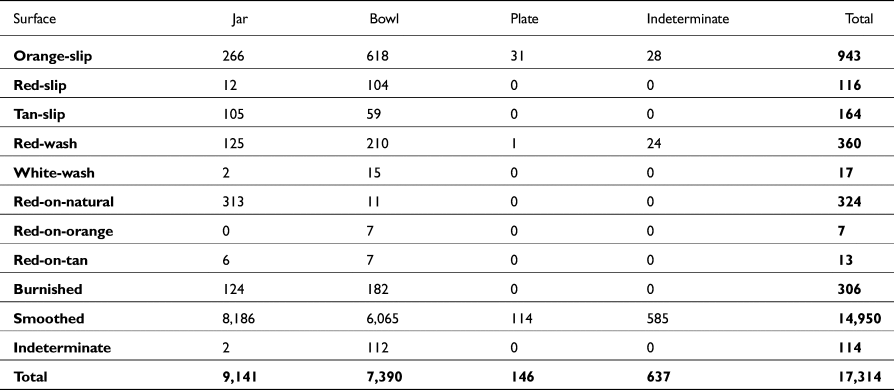
Smoothed-surface utilitarian wares generally conform to regionally recognized ceramic styles. The similar types include the Kan Group recovered from post-collapse contexts at Copan (Manahan Reference Manahan2003:157–174). Baudez and Becquelin (Reference Baudez and Becquelin1973) report the same surface treatment in the Period IV Rio Blanco–phase ceramics from Los Naranjos, and Healy (Reference Healy, Lange and Stone1984:149) comments on the inferiority of these vessels compared to earlier types. Together with these Early Postclassic regional wares, the locally manufactured pottery from the Northeast Complex is distinctive but nevertheless shares significant continuity with early types. In other words, practices shared among artisans and consumers (sensu Joyce Reference Joyce, Goodwin, Johnson and Figueroa2021) are connected across generations, and the people who built and lived in the Northeast Complex were the descendants of the Classic-period community that built, transformed, and ultimately terminated the monumental civic-ceremonial complex that makes up the Main Plaza of El Coyote.
A pattern of continuity, coupled with innovation and increased connection, also appears in the frequencies of exotic tradewares. The most common imports originate from communities closest to El Coyote (Table 3). Las Canoas, 10 km to the northeast of El Coyote, was a thriving crafting community that was engaged in the production of pottery that was to be exchanged with others in the Naco and Cacaulapa Valleys (Stockett Reference Stockett2005, Reference Stockett2007). Las Canoas was the source for 54 percent of all imported wares, primarily red-on-natural jars. Jars and bowls from the Naco Valley were the second most common (n = 843, or 25 percent of imports). Imports from most other regions tended to be rare, including trace amounts of polychromes from the Ulua valley, Capulin White from the lower Motagua valley, and Las Vegas Polychrome from Central Honduras (Joyce Reference Joyce2019).
Table 3. Imported pottery – Surface treatment tabulated by region of origin and form.
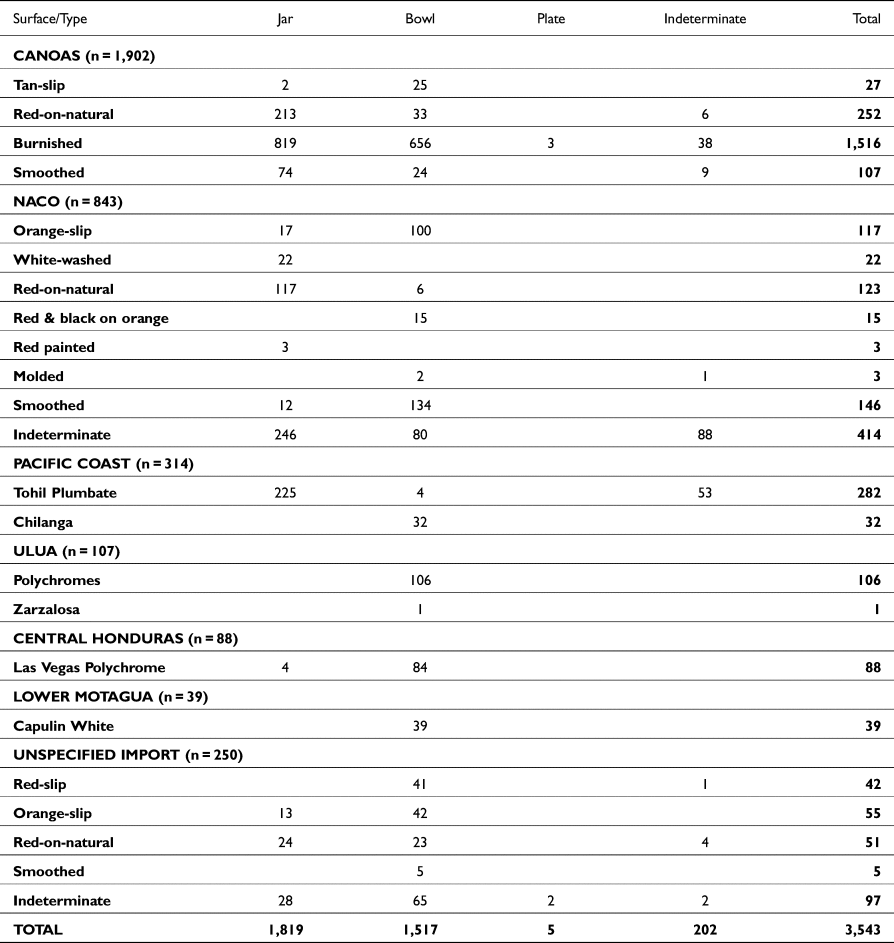
Imports from the Pacific Coast region include a few sherds recovered from fill contexts (n = 32) classified as an unspecified variety of Chilanga Red–painted resist and the more common Tohil Plumbate. In addition to 314 sherds of this type, five intact or restorable fancy Tohil Plumbate vessels and a single appliqued adornment—apparently curated after the vessel had been discarded—were collected from the Northeast Complex. Two complete vessels containing simple personal adornments and more elaborately carved jade pendants were recovered from a ritual context in association with Structure 242 (Figure 6).
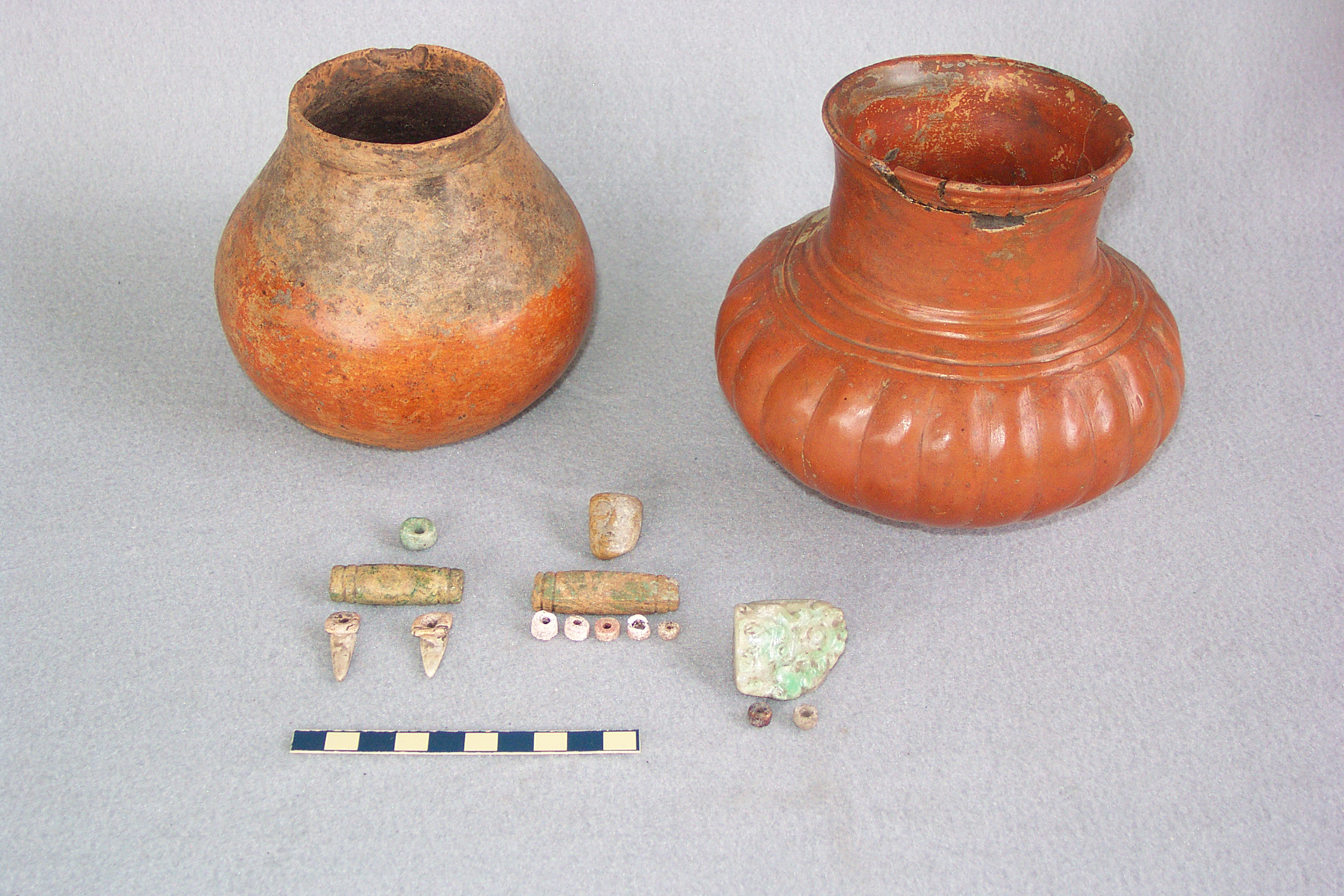
Figure 6. Tohil Plumbate vessels and associated ornamentation from a ritual offering, Structure 242.
Archaeological projects beyond the lower Cacaulapa Valley report Tohil Plumbate pottery in the Lake Yojoa region (Baudez and Becquelin Reference Baudez and Becquelin1973), the Comayagua Valley (Baudez Reference Baudez1976), the Motagua Valley (Sharer Reference Sharer, Chase and Rice1985), the Copan Valley (Bill Reference Bill and Braswell2014; Manahan Reference Manahan2003, Reference Manahan2004), the middle-Ulua Valley (Urban Reference Urban, Henderson and Beaudry-Corbett1993a), the Naco Valley (Urban Reference Urban, Henderson and Beaudry-Corbett1993b), and much farther to the south in the Greater Nicoya region of Nicaragua (Lange Reference Lange, Lange and Stone1984). It should be noted that the quantity of Tohil Plumbate recovered from neighboring valleys is quite low. Urban (personal communication 2005) notes, “In the approximately 850,000 sherds analyzed in the Naco Valley, there are two or three Plumbate sherds. The type is slightly more common in the Santa Barbara region, but by no means is common there.” Here, Plumbate is found together with obsidian from Pachuca, but both were encountered in far smaller amounts than reported from El Coyote (Edward Schortman, personal communication 2023).
Although fancy Tohil Plumbate is commonly recognized as a hallmark of the Early Postclassic period (Diehl Reference Diehl and Rice1993; Neff Reference Neff, Robinson and Davies2023) and used to date tenth- to eleventh-century contexts across Mesoamerica (Jordan Reference Jordan, Stanton, Taube, Coltman and Marengo Camacho2023; Mastache de Escobar et al. Reference Mastache de Escobar, Cobean and Healan2002:230), the implication of its absence warrants a note of caution. The use of ceramics as temporal markers creates limitations for other interpretations. Sites without this import may not have been abandoned at the end of the Classic period. Cultural or behavioral differences can account for absence of this or other highly decorated ritual vessels. Indeed, careful and thoughtful ceramic analyses can reveal differential access to these tradewares within the same polity (Chase and Chase Reference Chase and Chase2008) or settlement system (Urban et al. Reference Urban, Schortman, Ausec and Aimers2013).
Nevertheless, several trends are evident in this ceramic assemblage. First, proximity to the locale of manufacture strongly affects the relative quantities of imports. The vast majority (n = 77.5 percent) of imports come from Las Canoas and the Naco Valley. Second, imports from father away date to the Terminal Classic and Early Postclassic periods. Vessels from the Soconusco are well represented and provide evidence for an increase in pottery production for an export market (Neff Reference Neff and Voorhies1989:250; Neff et al. Reference Neff, Castillo, Sakai, Stanton, Taube, Coltman and Marengo Camacho2023:722). Finally, geographic proximity and temporal synchronicity cannot account for all aspects of the imported groups. The quantities of Tohil Plumbate and Las Vegas Polychrome pottery are significantly higher than in neighboring regions. This is an indication of broader political, social, and economic factors at play in the center.
Differences in exchange practices are also apparent when the lack of Fine Orange pottery is observed. Commonly cited as a Terminal Classic marker (Adams Reference Adams1971; Joyce Reference Joyce1986; Smith and Gifford Reference Smith, Gifford and Willey1965), Fine Orange wares are contemporary with the later occupation of El Coyote. Within the Sula Plain, Fine Orange is well represented (Joyce Reference Joyce1986) yet is absent in the Northeast Complex and Terminal Classic contexts in the Naco Valley (Urban Reference Urban, Henderson and Beaudry-Corbett1993b). For whatever reason, the inhabitants during the late occupation phase of El Coyote did not participate in the exchange network along which Fine Orange was traded.
Northeast Complex chipped stone
All artifacts in the lithic assemblage (n = 22,230) were classified using a behavioral or technological typology (e.g., Clark Reference Clark1988; Clark and Bryant Reference Clark and Bryant1997; Sheets Reference Sheets1975). Determination of geological provenance was done using visual sourcing (Braswell et al. Reference Braswell, Clark, Aoyama, McKillop and Glascock2000). Obsidian quarried from the Pachuca source in the northern rim of the Valley of Mexico was easily distinguishable from the closer sources of El Chayal and Ixtepeque. Although visual sourcing is a generally reliable technique, these two Guatemalan sources exhibit a range of characteristics that overlap. When encountering obsidian with traits common to both the Ixtepeque and El Chayal flows, source material was identified as “unknown.” Additionally, there are specimens quarried from regional sources—such as La Esperanza—that appear infrequently and are identified as “unknown.” This conservative approach provides a more reliable count for the better-known imported sources. Significant amounts of perlite, a volcanic glass like obsidian, were present in this assemblage. Small perlite nodules can be found near the confluence of the Cacualapa and Chamelecon Rivers, and in the foothills along the margins of the Naco Valley (Ross Reference Ross1997). These nodules are rarely larger than 2 cm in diameter and were not suitable for the manufacture of prismatic blades or bifacial points. Perlite was utilized as a material for informal expedient tools.
Many of the chipped stone artifacts (n = 13,029) in the Northeast Complex assemblage were manufactured from locally available chert, and they were classified as debitage or informal tools, such as edge-modified flakes. The remaining sample consists of obsidian and perlite source materials collected from the Northeast Complex (n = 8,618) and a comparative sample came from an elite residence associated with the Classic-period Main Plaza (n = 445). During the late occupation of El Coyote, households relied on a generalized flake—core industry supplemented with prismatic blades.
Blades were quite common and found in association with every sampled structure. However, evidence for the specialized production of prismatic blades is all but absent in the Northeast Complex. The lack of production debris may reflect a local practice of sequestering specialists away from consumers (McFarlane and Schortman Reference McFarlane and Schortman2017). Another possibility is that these tools entered the lower Cacaulapa Valley as finished commodities. Given the quantity of blades recovered in the Northeast Complex and the possibility of breakage during transportation, the importation of finished blades seems impractical. Likely, the sampling strategy simply failed to encounter deposits of debris related to specialized blade production.
Bifacially worked formal tools reduced from chert and obsidian (n = 138) were processed separately. Based on comparison with Classic-period contexts, there was an increase in the production and use of bifacial points during the late occupation of El Coyote. Often cited as evidence for an increase in raiding and warfare, these points are noted at Terminal Classic and Early Postclassic sites throughout the region (Aoyama Reference Aoyama1996; Manahan Reference Manahan2003). Points from the Northeast Complex exhibit a wide range in form and craftmanship (McFarlane Reference McFarlane2005:665–677), perhaps indicative of different tasks, such as an increase in hunting practices, or reflecting a technological response to the unreliability of obtaining nonlocal source materials. Whatever the explanation, there is a noticeable absence of production debris, such as bifacial thinning flakes, in Northeast Complex contexts.
A large deposit of bifacial production debris was identified in the fill of a raised platform along the southeastern margin of the monumental core of El Coyote, however. Over 54 kg (120 lb.) of debitage were collected from this context. Although the Southeast Group falls outside the scope of this article, the find suggests that craft production was organized around different loci at the center. At this time, it is not possible to directly trace finished tools with the production debris, but the presence of finished bifaces and paucity of production debris in Northeast Complex contexts may reflect measures to remove potentially hazardous debitage from commonly used areas (Clark Reference Clark, Staski and Sutru1991; Santley and Kneebone Reference Santley, Kneebone, Santley and Hirth1993:48).
In addition to the increased frequency of bifacial points, two aspects of the lithic assemblage are directly related to determinations of the chronological designation of the Northeast Complex. First, obsidian from the Pachuca source was found in relatively high quantities, and it accounts for nearly 17 percent of the nonchert mass (19.4 percent by count). The distinctive and easily identified green obsidian was the second most imported material after obsidian from Ixtepeque, and it appears almost exclusively as final series prismatic blades. Of the 1,684 specimens, eight were classified as initial series blades or flakes because they retained a small amount of cortex, two were classified as percussion blades or flakes, and a single indeterminate fragment was recorded.
Pachuca obsidian was widely and evenly distributed throughout Northeast Complex contexts. By density, there is little disparity among structures (Table 4). Structure 217 yielded the highest quantity and density of this material. The size, internal organization, and associated material remains suggest that this was a nonresidential building serving as a storehouse for the curation of special objects and as a locus for private rituals (McFarlane Reference McFarlane2005:94–96; also see Urban and Schortman Reference Urban and Schortman2004:260–262, for a comparable structure at Site 128 in the Naco Valley). The slightly higher density of blades made from the green obsidian may be related to ritual activities. However, material from Pachuca is so widespread and in a variety of contexts related to mundane activities that it seems clear that it was treated no differently than obsidian from any other source. The ubiquitous distribution of this material suggests that it was relatively abundant, and access was unrestricted.
Table 4. Distribution of obsidian from the Pachuca, Hidalgo, source.
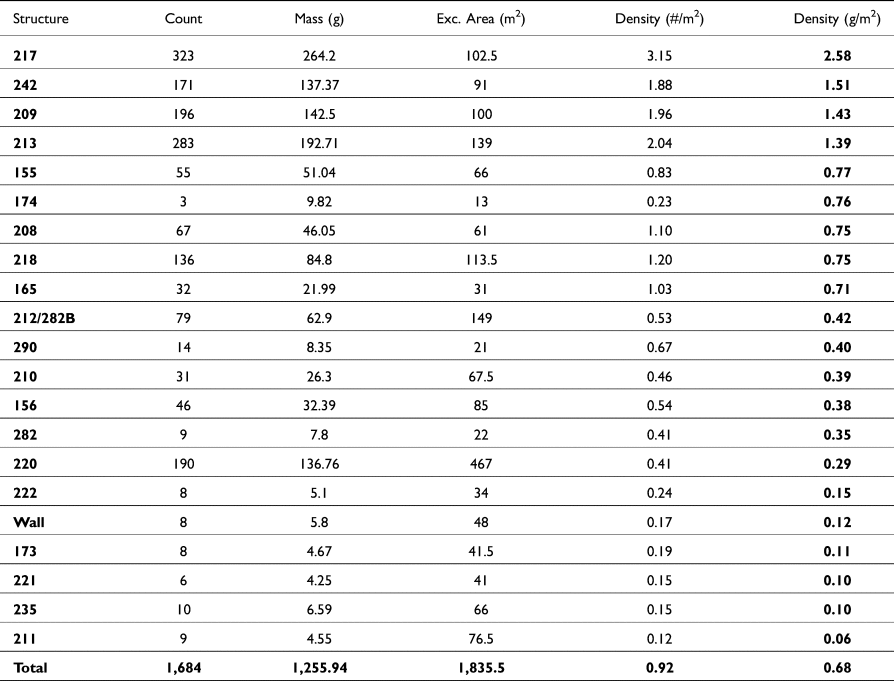
Second, nearly all (n = 628, 93 percent) of the proximal or complete blades from the late phase of occupation exhibit pecked-and-ground (simplified below as “ground”) platforms (Table 5). There is some variation by source material, but grinding is clearly the preferred preparation for polyhedral core platforms. This platform preparation technique can be traced to Epiclassic Xochicalco, Morelos, and, by the Postclassic period, grinding has all but replaced other methods of core preparation (Healan Reference Healan2009:104). This pattern is consistent with Terminal Classic and Postclassic evidence from southeastern Mesoamerica (Braswell Reference Braswell, Smith and Berdan2003:141).
Table 5. Distribution of platform treatment by obsidian source material, all Northeast Complex structures, and Op. 47.
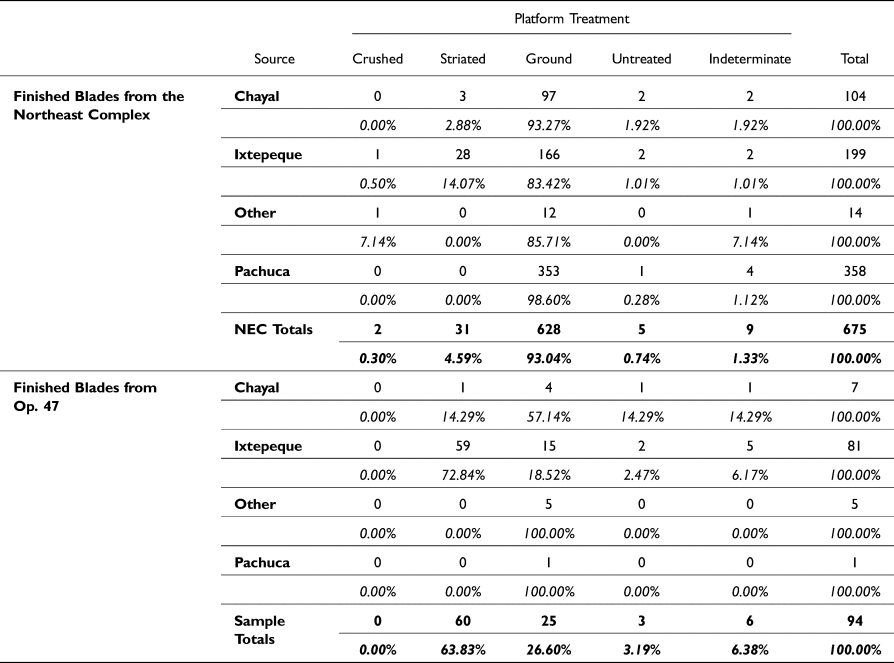
Copper production at El Coyote
Metallurgy occurred relatively late in the cultural sequence of Mesoamerica (Hosler Reference Hosler2009), and archaeological evidence for the specialized production of copper objects is rarely reported outside of west Mexico (Simmons and Shugar Reference Simmons, Shugar, Shugar and Simmons2013). By no means is the technology common in pre-Columbian contexts, but emerging evidence suggests that specialized metalworking is both earlier and more widespread than originally thought (Paris Reference Paris2008; Shugar and Simmons Reference Shugar and Simmons2013). Dedicated facilities, likely dating to the late ninth and tenth centuries, in the southeastern area of El Coyote suggest that artisans were engaged in the process of smelting copper extracted from deposits in or near the lower Cacaulapa Valley. Modern mining activities some _6.5_km (4 mi.) west of El Coyote likely destroyed the “Quimistán Cave of Bells” described over a century ago by A. Hooton Blackiston (Reference Blackiston1910).
Urban and colleagues (Reference Urban, Schortman, Ausec and Aimers2013b) describe a series of features dedicated to copper smelting. Each stage in the reduction of copper alloys from geological contexts was associated with specific activity areas located on a low terrace between the Cacaulapa River and the higher elevations upon which El Coyote was built. Anvils, furnaces, slag, and other materials related to this practice were recovered in abundance. Aside from metalworking and the consumption of food—as inferred from the remnants of undecorated plates and comales—no other domestic or ritual activities were conducted in this area. The absence of finished copper objects in excavated contexts at El Coyote suggests that these materials were produced for the purpose of export and were not distributed among households in the local community. This is generally consistent with the production sequence in the principal metalworking tradition of west Mexico (Hosler Reference Hosler, Smith and Berdan2003) and from other “affluent production zones” in southeastern Mesoamerica (Paris Reference Paris2008:44).
Dating the metalworking facilities is complicated by the shallow and occasionally mixed deposits, but these activities at El Coyote are thought to fall during the late ninth to tenth centuries. Although absolute dates could not be established, the chronological designation was determined by association with cultural materials in securely dated contexts. Unsealed remains did yield low amounts of modern ceramics, which were always associated with prehistoric remains and therefore chronologically ambiguous. Sealed contexts, on the other hand, consist solely of pre-Columbian materials consistent with types common to the Terminal Classic and Early Postclassic periods (Urban et al. Reference Urban, Schortman, Ausec and Aimers2013b:100–102). Slag and other byproducts of smelting were used as building material in constructions contemporary with the later occupation of the Northeast Complex. Altogether, the most reliable contexts date to the last phase of pre-Columbian occupation at El Coyote.
The evidence for copper processing at El Coyote does not confirm the chronological determinations for this community. Indeed, the tenuous dating of the special purpose workshop depends on material comparisons with contexts elsewhere at the site. I include it here to help explain the circumstances for such an unusual pattern of persistence and extralocal ties during the tenth century. In the centuries preceding a.d. 900, El Coyote was a thriving community but had little material connections with or influence over more distant centers in southeastern Mesoamerica (Urban Reference Urban2016:245). How then, was this society able to capture material resources and valued trade goods moving across pan-Mesoamerican exchange spheres? The answer, in part, has to do with the presence of copper-bearing deposits and the specialized technology needed to produce goods for consumers beyond the lower Cacaulapa Valley. Demand for these resources grew during the tenth century coincident with the spread of a pan-Mesoamerican ideology. Elites and commoners alike attended to the associations between the sound and color of copper objects and shared sacred conceptions of a Flowery Heaven (Burkhart Reference Burkhart1992; Hosler Reference Hosler1995) or the celestial paradise of the Flower World (Jordan Reference Jordan, Stanton, Taube, Coltman and Marengo Camacho2023:139; Stanton et al. Reference Stanton, Taube, Coltman, Stanton, Taube, Coltman and Marengo Camacho2023; Taube Reference Taube, Stanton and Kathryn Brown2020).
Discussion
The material assemblage from El Coyote's Northeast Complex includes three of the most recognizable and widely dispersed chronological markers for late pre-Columbian Southeast Mesoamerica: Tohil Plumbate pottery, obsidian from Pachuca, and copper metallurgy. The architecture and organization of the built environment reflect a set of principles that place the complex in closer association with later societies than those found during earlier periods. This interpretation is further supported by radiocarbon assays, which situate the founding and relatively brief occupation of the Northeast Complex in the tenth century. When placed in context with regional chronologies, the inconsistencies in the way archaeologists have interpreted the evidence for this macroregional pattern of exchange are pronounced.
To reconcile regional chronologies with a pan-Mesoamerican horizon, researchers have conflated (or disregarded) the distinction between temporal periods and cultural developments. This issue is both empirical and semantic. The evidence from the Northeast Complex dates primarily to the tenth century. The presence of Tohil Plumbate, green obsidian from Pachuca, and metallurgy are characteristics of a macroregional pattern that date to this time period and encompasses highland Mexico through the Maya lowlands and into northern Central America (Baudez Reference Baudez1966:319-320; Healy Reference Healy1980, Reference Healy, Lange and Stone1984:148-149; Kolbenstetter Reference Kolbenstetter and Smith2022; Neff Reference Neff2003; Neff and Bishop Reference Neff and Bishop1988; Shepard Reference Shepard1948; Smith and Berdan Reference Smith, Berdan, Smith and Berdan2003, ed.; Stanton et al. Reference Stanton, Taube, Coltman and Marengo Camacho2023, ed.; Strong Reference Strong1935:142–143; Urban et al. Reference Urban, Schortman, Ausec and Aimers2013b). Indeed, along with an international symbol set, these traits are commonly cited as chronological markers (Boone and Smith Reference Boone, Smith, Smith and Berdan2003; Diehl Reference Diehl and Rice1993; Ringle et al. Reference Ringle, Negrón and Bey1998; Smith Reference Smith, Smith and Berdan2003; Smith and Heath-Smith Reference Smith and Heath-Smith1980).
Perhaps the best evidence for comparison is Tohil Plumbate, which helps to define many of the ceramic phases and cultural deposits across the Yucatan. For example, fancy Tohil Plumbate, though not abundant, is a marker for the Late Sotuta phase between a.d. 900 and 1050 at Chichen Itza (Cobos Reference Cobos Palma, Demarest, Rice and Rice2004, Reference Cobos Palma, Kowalski and Kristan-Graham2011) and Ek Balam (Ringle et al. Reference Ringle, Bey, Freeman, Hanson, Houck, Gregory Smith, Demarest, Rice and Rice2004; see also Bey and Ringle Reference Bey, Ringle, Kowalski and Kristan-Graham2011). These dates are consistent with a postabandonment offering of Tohil Plumbate at the Uxmal Round Structure circa a.d. 950 (Carmean et al. Reference Carmean, Dunning, Kowalski, Demarest, Rice and Rice2004:432). At ports of trade across the north coast of the Yucatan, Plumbate ceramics are associated with contexts dating somewhat earlier—a.d. 850 to 1100 (Andrews et al. Reference Andrews, Negrón, Castellanos, Palma and Rivero1988; Glover et al. Reference Glover, Hruby, Rissolo, Ball, Glascock and Steven Shackley2018).
Across the southern Gulf Coast in Campeche and Tabasco, Tohil Plumbate is associated with contexts dating between a.d. 900 and 1000 (Ball Reference Ball, Chase and Rice1985:239). This tradeware is associated with Tollan-phase complexes between a.d. 900 and 1150 at Tula (Healan et al. Reference Healan, Cobean and Bowsher2021; Jordan Reference Jordan, Stanton, Taube, Coltman and Marengo Camacho2023:129; Mastache de Escobar et al. Reference Mastache de Escobar, Cobean and Healan2002:230). Radiocarbon assays from El Palacio in Michoacan further restrict Plumbate and Tollan-related contexts to a.d. 975–1150 (Jadot et al. Reference Jadot, Pereira, Neff and Glascock2019:322). Further abroad, the presence of Tohil Plumbate has also been cited in association with late Bayal or post-Bayal phase deposits circa a.d. 930 at Seibal (Sabloff Reference Sabloff1975:224).
Although the site of production has yet to be identified (Neff Reference Neff, Robinson and Davies2023; Neff et al. Reference Neff, Castillo, Sakai, Stanton, Taube, Coltman and Marengo Camacho2023), fancy Tohil Plumbate was no longer produced after a.d. 1100 (Neff Reference Neff and Martinón-Torres2014:8). Finally, the increased circulation of prismatic blades reduced from Pachuca obsidian begins after a.d. 900 following a reorganization of production and the political economy during the Tollan phase of Tula (Healan Reference Healan1993, Reference Healan2009, Reference Healan, Kowalski and Kristan-Graham2011). Put simply, there is consensus regarding the chronological placement of this macroregional exchange pattern to a.d. 900–1100.
Disagreement comes not from the timing (or temporal designation) of this pattern but from the interpretation in terms of its cultural and political significance. Part of this disagreement reflects regional considerations. Beyond the Maya area, the tenth century falls near the end of the Epiclassic period (Smith and Berdan Reference Smith and Berdan2003:4). In the centuries following the fall of Teotihuacan, commercialized long-distance exchange increased, likely a result of decentralized trade undertaken by specialized merchants who drew distant regions closer through their entrepreneurial practices (Diehl and Berlo Reference Diehl and Berlo1989). This pattern leads to the Early Postclassic period, the beginning of monumental construction at Tula Grande, the emergence of an international symbol set, and increased interaction between representatives of Tula and Chichen Itza (Bey and Ringle Reference Bey, Ringle, Kowalski and Kristan-Graham2011).
Within the Maya area, researchers consider the tenth century to be Terminal Classic or Early Postclassic, depending on the presence or absence of chronologically sensitive evidence from each site. This is a culture-historical issue that fails to account for behavioral causes to material variation (Braswell Reference Braswell, Stanton, Taube, Coltman and Marengo Camacho2023; Chase and Chase Reference Chase and Chase2008; Urban et al. Reference Urban, Schortman, Ausec and Aimers2013). Historically, the Terminal Classic was proposed by Patrick Culbert (Reference Culbert and Culbert1973a:16–17) to describe both continuity with Late Classic cultural patterns and the destruction of those patterns. One of these traditions—the declining use of Long Count dates in the dedication of stela—provides temporal context for the Terminal Classic period from a.d. 780 (9.18.0.0.0) to a.d. 909 (10.4.0.0.0). However, because the Terminal Classic period denotes the cultural processes of collapse—such as demographic decline, abandonment of urban centers, sociopolitical fragmentation, and simplification of material assemblages due to the reduction of craft specialists—it is possible to extend this period by a century or more (Chase and Rice Reference Chase, Rice, Chase and Rice1985b:1–2). Nevertheless, a common convention is to mark the transition between Classic and Postclassic periods around a.d. 900/950 (Braswell Reference Braswell and Braswell2015).
The cultural processes used to describe the Early Postclassic period include the decline or absence of Late Classic patterns coupled with the introduction or rise of processes indicative of late pre-Columbian Mesoamerica. Technological advances in the production of prismatic blades (Healan Reference Healan2009) and the innovation of metallurgy (Hosler Reference Hosler2009; Paris Reference Paris2008; Shugar and Simmons Reference Shugar and Simmons2013), for example, help to define the Postclassic period. It is during this period that alternatives to exclusionary dynastic political rule become increasingly common (McFarlane Reference McFarlane2005), and strategies are implemented that draw on collective action (e.g. Blanton and Fargher Reference Blanton and Fargher2016; Carballo Reference Carballo2013). The Early Postclassic period is also a time of increased intensity of interregional interaction and connectivity across a variety of behavioral domains, including militarism, long-distance trade, and religious or ideological movements (Bey and Ringle Reference Bey, Ringle, Kowalski and Kristan-Graham2011; Feinman Reference Feinman, Carrasco and Englehardt2019; Geurds Reference Geurds, Stanton, Taube, Coltman and Marengo Camacho2023:646; Glover and Rissolo Reference Glover, Rissolo, Stanton, Taube, Coltman and Marengo Camacho2023; Ringle et al. Reference Ringle, Negrón and Bey1998; Smith Reference Smith, Smith and Berdan2003). Although the Early Postclassic period has been disparagingly characterized as “decadent” or inferior to preceding generations, it should be defined by innovation and as a precursor to Late Postclassic processes (Braswell Reference Braswell, Stanton, Taube, Coltman and Marengo Camacho2023:316; Stanton et al. Reference Stanton, Taube, Coltman, Stanton, Taube, Coltman and Marengo Camacho2023).
A result of conflating temporal periods with cultural developments is the inconsistent application of terminology. Mesoamericanists may ascribe different cultural periods to the same century depending on how they interpret specific facets of the evidence and their interests: the collapse of Late Classic sociopolitical organization or the emergence of international exchange spheres (Braswell Reference Braswell, Smith and Berdan2003:141, 146; Joyce Reference Joyce1986, Reference Joyce2019). Others are more inclusive and use both—Terminal Classic and Early Postclassic—to describe the transitional nature of this period and accommodate culture-historical conventions between regions (Glover et al. Reference Glover, Hruby, Rissolo, Ball, Glascock and Steven Shackley2018:476; Urban et al. Reference Urban, Schortman, Ausec and Aimers2013a). In a widely cited article by Anthony Andrews and colleagues (Reference Andrews, Andrews and Castellanos2003), a convincing argument was proposed to extend the Terminal Classic period through the eleventh century and remove the Early Postclassic period entirely (but see Stanton and Bey Reference Stanton, Bey, Stanton, Taube, Coltman and Marengo Camacho2023). In some regions, chronological debates have grown so contentious that scholars may solely discuss cultural processes and circumvent the temporal issue entirely to avoid acrimony (Kepecs Reference Kepecs, Kowalski and Kristan-Graham2011:95).
To be clear, I contend that the tenth-century contexts at El Coyote correspond best with the cultural processes of the Early Postclassic period for two reasons. The first is empirical. There is a great deal of consistency with comparable assemblages also considered to be Early Postclassic. To illustrate this point, I turn to the Ejar-phase postcollapse settlement of Copan. Debate about the nature and timing of the collapse of the Copan polity and hinterland notwithstanding (Braswell Reference Braswell1992; Manahan and Canuto Reference Manahan and Canuto2009; McNeil et al. Reference McNeil, Barrios, Hruby, Meissner, Tokovinine, García and Morakawa2022; Webster and Freter Reference Webster and Freter1990; Webster et al. Reference Webster, Freter, Storey, Demarest, Rice and Rice2004), there is convincing evidence for the abandonment of the monumental center during the mid-ninth century, followed by a tenth-century resettlement among the monumental ruins by a distinctly different postcollapse society (Fash et al. Reference Fash, Andrews, Manaham, Demarest, Rice and Rice2004; Manahan Reference Manahan, Stanton and Magnoni2008).
The Ejar settlement shares striking similarities with those described at El Coyote and in central Honduras (Manahan Reference Manahan2004:120). Architecture consists of low-lying platforms supporting perishable superstructures constructed of wattle and daub. Daily domestic and ritual activities were carried out within these buildings, which were situated around an unmodified communal plaza. Locally manufactured utilitarian pottery is crude, or charitably described as favoring “expedience over standardization of forms and attention to finishing techniques” (Manahan and Canuto Reference Manahan and Canuto2009:570). The presence of Tohil Plumbate; Las Vegas Polychrome; and obsidian blades with ground platforms reduced from the Mexican sources of Pachuca, Pico de Orizaba, and Ucareo places the Ejar inhabitants within the tenth-century pan-Mesoamerican exchange networks.
This material pattern is associated with nine radiocarbon assays anchoring this brief occupation between a.d. 970 and 1085, which Manahan (Reference Manahan2004:114) conservatively expands to a.d. 950–1100. The Ejar settlement is both culturally and temporally separated from dynastic rule of the Copan polity and relatively brief Terminal Classic period (e.g. Bill Reference Bill and Braswell2014; Viel Reference Viel, Henderson and Beaudry-Corbett1993:17). Due to the absolute dates and chronologically relevant material culture, both the Ejar settlement and the Northeast Complex at El Coyote not only are contemporaneous but also reflect sensibilities indicative of the Early Postclassic period.
The second reason is semantic—that is, “Early Postclassic” cultural processes can be interpreted from the tenth-century contexts of El Coyote. Although the Northeast Complex represents continuity with the Classic population of El Coyote, it is also a rejection or break from the Classic-period notions of sociopolitical organization, exclusionary leadership, and power relations. The decline of cultural patterns associated with the Classic period ended with the abandonment of the Main Plaza and the disassembling of its architectural facades. Leaving behind these ancestral trappings, the community engaged with the increasingly commercialized pan-Mesoamerican exchange spheres and international information networks, which in part help to define the Postclassic period. Along with many of the Early Postclassic centers of highland Mexico and the Northern Lowlands, the population living at El Coyote represent continuity and adaptive change (Braswell Reference Braswell, Stanton, Taube, Coltman and Marengo Camacho2023:337).
To better understand the macroregional developments occurring during the tenth century, we need to be clearer and more precise in the construction of macroregional chronologies. The evidence for demographic and sociopolitical transformations demonstrates that major centers across the Maya Lowlands fell into decline during the ninth and tenth centuries. Contemporary with these patterns of collapse is evidence for increasing international trade. By failing to align the temporal framework with cultural processes, we limit our ability to determine what—if any—relationship exists between increasingly decentralized sociopolitical organizations and expanding mercantile economies (Braswell and Glascock Reference Braswell, Glascock and Glascock2002; Golitko and Feinman Reference Golitko and Feinman2015; Golitko et al. Reference Golitko, Meierhoff, Feinman and Williams2012). The fact that the tenth-century complex of resources, commodities, and ideological practices circulating through pan-Mesoamerican exchange networks does not fit easily within existing chronological frameworks should not be a source of consternation. Rather, it should be seen as an opportunity for asking more nuanced questions about the entanglements of craft production, specialized trade, religious movements, and cultural change.
Conclusion
In 2018, Geoffrey Braswell, then coeditor of Latin American Antiquity, commented on a debate over the chronology at Teotihuacan. He noted, “Chronologies are fragile structures that depend upon each other like a house of cards. Changes to the chronology of a pivotal city often have consequences for distant sites” (Braswell Reference Braswell2018: 403). My purpose with this article is not to upset the fragile structure but instead to lend support and reinforce this chronological house of cards by coupling chronological markers with radiocarbon assays. In doing so, presenting the extent of a tenth-century international interaction network—described by many others—should not contradict models of sociopolitical decline. Rather, it is now clear that the growth of Late Postclassic mercantile economies can be traced to the trade-oriented endeavors of communities on both a local and regional scale. At the same time, it is important to recognize that variation in the distribution of temporally sensitive materials can be the result of social practices and not due to abandonment or persistence (Chase and Chase Reference Chase and Chase2008; Urban et al. Reference Urban, Schortman, Ausec and Aimers2013). Despite the increased connectivity among communities resulting in the exchange of tradewares, obsidian, and metal objects, not all people experienced the same capability to acquire these valued goods.
In this article, I place the archaeological evidence from El Coyote into the chronological context of the ninth and tenth centuries. El Coyote grew rapidly during the Classic period but underwent significant reorganization by a.d. 900, resulting in the construction of the Northeast Complex. Although the people who built and lived in this new complex were the descendants of the founders of El Coyote, they participated in transformative regional and international developments. Radiocarbon assays and comparison with interregional collections help anchor the material assemblage from the late occupation of El Coyote to a.d. 900–1050. The presence of fancy Tohil Plumbate, obsidian imported from Pachuca, and copper metallurgy is consistent with cultural processes described elsewhere as Early Postclassic (Stanton et al. Reference Stanton, Taube, Coltman and Marengo Camacho2023, ed.).
It is worth noting that a relatively marginal village in a narrow valley with little agricultural viability participated in these macroregional trade networks. That anyone in this community was aware of the potential for copper production suggests that the movement of technical expertise was robust, to say the least. Once the copper was extracted, the final products were removed from the valley for consumption elsewhere. One outcome of the present study is to suggest how metallurgy, long-distance trade, and the Early Postclassic sociopolitical transformation of El Coyote may have been entangled.
El Coyote was, of course, important to the people who called it home. However, the relative paucity of tradewares through much of its Classic-period occupation suggests that people living beyond the valley gave it little attention. It was not until the late ninth century, at the earliest, that the situation began to change. Just as many major centers around it were falling into decline, the inhabitants of El Coyote reimagined their political economy and engaged with an increasingly integrated Mesoamerican commercialized economy.
Acknowledgments
This article is based on investigations conducted with the permission and support of my colleagues at the Instituto Hondureño de Antropología e Historia. The research was made possible through generous funding provided by Kenyon College, the University of Buffalo, and the National Science Foundation. Johnson County Community College provided many in-kind resources, including sabbatical leave, which allowed me to bring this study to its conclusion. Many of the excavations in the Northeast Complex were supervised by students of the Kenyon-Honduras Program. In particular, I wish to thank Leigh Anne Ellison, Meghan Kerley, Brandon Liverance, Adam Taplin, and Georlin Thorne not only for the care and attention they paid to these efforts but also for the enthusiasm they brought to the work. Alejandro Figueroa translated the Spanish summary, and I am grateful for his patience and efforts. The residents of Petoa and Pueblo Nuevo were welcoming and provided their expertise, without which it would have been impossible to complete this research. I am appreciative of the comments of three anonymous reviewers, who pointed me in the direction of current research. I am especially grateful to Geoffrey Braswell, Edward Schortman, and Patricia Urban for their thoughtful review of earlier drafts of this article. This work is much improved by their insights. Any remaining errors or lack of clarity is solely my responsibility.
Data availability statement
All excavated archaeological materials used in this study are curated by the Instituto Hondureño de Antropología e Historia.
Competing interests
The author declares no competing interests.














